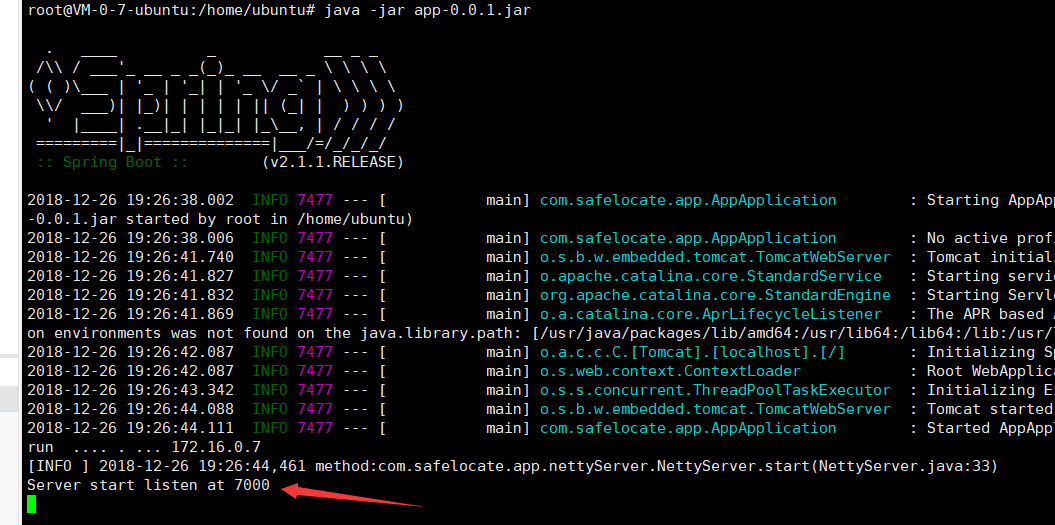SpringBoot集成netty实现客户端服务端交互和做一个简单的IM
看了好几天的netty实战,慢慢摸索,虽然还没有摸着很多门道,但今天还是把之前想加入到项目里的
一些想法实现了,算是有点信心了吧(讲真netty对初学者还真的不是很友好......)
首先,当然是在SpringBoot项目里添加netty的依赖了,注意不要用netty5的依赖,因为已经废弃了
<!--netty-->
<dependency>
<groupId>io.netty</groupId>
<artifactId>netty-all</artifactId>
<version>4.1.32.Final</version>
</dependency>
将端口和IP写入application.yml文件里,我这里是我云服务器的内网IP,如果是本机测试,用127.0.0.1就ok
netty:
port: 7000
url: 172.16.0.7
在这之后,开始写netty的服务器,这里服务端的逻辑就是将客户端发来的信息返回回去
因为采用依赖注入的方法实例化netty,所以加上@Component注解
package com.safelocate.app.nettyServer; import io.netty.bootstrap.ServerBootstrap;
import io.netty.channel.*;
import io.netty.channel.nio.NioEventLoopGroup;
import io.netty.channel.socket.nio.NioServerSocketChannel;
import org.apache.log4j.Logger;
import org.springframework.stereotype.Component; import java.net.InetSocketAddress; @Component
public class NettyServer {
//logger
private static final Logger logger = Logger.getLogger(NettyServer.class);
public void start(InetSocketAddress address){
EventLoopGroup bossGroup = new NioEventLoopGroup(1);
EventLoopGroup workerGroup = new NioEventLoopGroup();
try {
ServerBootstrap bootstrap = new ServerBootstrap()
.group(bossGroup,workerGroup)
.channel(NioServerSocketChannel.class)
.localAddress(address)
.childHandler(new ServerChannelInitializer())
.option(ChannelOption.SO_BACKLOG, 128)
.childOption(ChannelOption.SO_KEEPALIVE, true);
// 绑定端口,开始接收进来的连接
ChannelFuture future = bootstrap.bind(address).sync();
logger.info("Server start listen at " + address.getPort());
future.channel().closeFuture().sync();
} catch (Exception e) {
e.printStackTrace();
bossGroup.shutdownGracefully();
workerGroup.shutdownGracefully();
}
} }
Server.java
当然,这里的ServerChannelInitializer是我自己定义的类,这个类是继承ChannelInitializer<SocketChannel>的,里面设置出站和入站的编码器和解码器
package com.safelocate.app.nettyServer; import io.netty.channel.ChannelInitializer;
import io.netty.channel.socket.SocketChannel;
import io.netty.handler.codec.string.StringDecoder;
import io.netty.handler.codec.string.StringEncoder;
import io.netty.util.CharsetUtil;
public class ServerChannelInitializer extends ChannelInitializer<SocketChannel> {
@Override
protected void initChannel(SocketChannel channel) throws Exception {
channel.pipeline().addLast("decoder",new StringDecoder(CharsetUtil.UTF_8));
channel.pipeline().addLast("encoder",new StringEncoder(CharsetUtil.UTF_8));
channel.pipeline().addLast(new ServerHandler());
}
}
ServerChannelinitializer.java
最好注意被别decoder和encoder写成了一样的,不然会出问题(我之前就是不小心都写成了StringDecoder...)
在这之后就是设置ServerHandler来处理一些简单的逻辑了
package com.safelocate.app.nettyServer; import io.netty.channel.ChannelHandlerContext;
import io.netty.channel.ChannelInboundHandlerAdapter;
import io.netty.channel.SimpleChannelInboundHandler; import java.io.IOException;
import java.io.OutputStream;
import java.io.PrintWriter;
import java.net.InetAddress;
import java.net.Socket; public class ServerHandler extends ChannelInboundHandlerAdapter {
@Override
public void channelActive(ChannelHandlerContext ctx) {
System.out.println("channelActive----->");
} @Override
public void channelRead(ChannelHandlerContext ctx, Object msg) throws Exception {
System.out.println("server channelRead......");
System.out.println(ctx.channel().remoteAddress()+"----->Server :"+ msg.toString());
//将客户端的信息直接返回写入ctx
ctx.write("server say :"+msg);
//刷新缓存区
ctx.flush();
} @Override
public void exceptionCaught(ChannelHandlerContext ctx, Throwable cause) throws Exception {
cause.printStackTrace();
ctx.close();
}
}
ServerHandler.java
准备工作到这里,现在要做到就是去启动这个程序
将AppApplication实现CommandLineRunner这个接口,这个接口可以用来再启动SpringBoot时同时启动其他功能,比如配置,数据库连接等等
然后重写run方法,在run方法里启动netty服务器,Server类用@AutoWired直接实例化
package com.safelocate.app; import com.safelocate.app.nettyServer.NettyServer;
import io.netty.channel.ChannelFuture;
import org.springframework.beans.factory.annotation.Autowired;
import org.springframework.beans.factory.annotation.Value;
import org.springframework.boot.CommandLineRunner;
import org.springframework.boot.SpringApplication;
import org.springframework.boot.autoconfigure.SpringBootApplication; import java.net.InetAddress;
import java.net.InetSocketAddress;
@SpringBootApplication
public class AppApplication implements CommandLineRunner { @Value("${netty.port}")
private int port; @Value("${netty.url}")
private String url; @Autowired
private NettyServer server; public static void main(String[] args) {
SpringApplication.run(AppApplication.class, args);
}
@Override
public void run(String... args) throws Exception {
InetSocketAddress address = new InetSocketAddress(url,port);
System.out.println("run .... . ... "+url);
server.start(address);
}
}
AppApplication.java
ok,到这里服务端已经写完,本地我也已经测试完,现在需要打包部署服务器,当然这个程序只为练手...
控制台输入mvn clean package -D skipTests 然后将jar包上传服务器,在这之后,需要在腾讯云/阿里云那边配置好安全组,将之前yml文件里设定的端口的入站
规则设置好,不然访问会被拒绝
之后java -jar命令运行,如果需保持后台一直运行 就用nohup命令,可以看到程序已经跑起来了,等待客户端连接交互

之后就是写客户端了,客户端其实是依葫芦画瓢,跟上面类似
Handler
package client; import io.netty.channel.ChannelHandlerContext;
import io.netty.channel.ChannelInboundHandlerAdapter; public class ClientHandler extends ChannelInboundHandlerAdapter {
@Override
public void channelActive(ChannelHandlerContext ctx) {
System.out.println("ClientHandler Active");
} @Override
public void channelRead(ChannelHandlerContext ctx, Object msg) {
System.out.println("--------");
System.out.println("ClientHandler read Message:"+msg);
} @Override
public void exceptionCaught(ChannelHandlerContext ctx, Throwable cause) {
cause.printStackTrace();
ctx.close();
} }
ClientHandler.java
ChannelInitializer
package client; import io.netty.channel.ChannelInitializer;
import io.netty.channel.ChannelPipeline;
import io.netty.channel.socket.SocketChannel;
import io.netty.handler.codec.string.StringDecoder;
import io.netty.handler.codec.string.StringEncoder;
import io.netty.util.CharsetUtil; public class ClientChannelInitializer extends ChannelInitializer<SocketChannel> {
protected void initChannel(SocketChannel channel) throws Exception {
ChannelPipeline p = channel.pipeline();
p.addLast("decoder", new StringDecoder(CharsetUtil.UTF_8));
p.addLast("encoder", new StringEncoder(CharsetUtil.UTF_8));
p.addLast(new ClientHandler());
}
}
ClientChannelInitializer
主函数所在类,即客户端
package client; import io.netty.bootstrap.Bootstrap;
import io.netty.channel.*;
import io.netty.channel.nio.NioEventLoopGroup;
import io.netty.channel.socket.SocketChannel;
import io.netty.channel.socket.nio.NioSocketChannel;
import io.netty.handler.codec.string.StringDecoder;
import io.netty.handler.codec.string.StringEncoder; public class Client {
static final String HOST = System.getProperty("host", "服务器的IP地址");
static final int PORT = Integer.parseInt(System.getProperty("port", "7000"));
static final int SIZE = Integer.parseInt(System.getProperty("size", "256")); public static void main(String[] args) throws Exception {
sendMessage("hhhh");
}
public static void sendMessage(String content) throws InterruptedException{
// Configure the client.
EventLoopGroup group = new NioEventLoopGroup();
try {
Bootstrap b = new Bootstrap();
b.group(group)
.channel(NioSocketChannel.class)
.option(ChannelOption.TCP_NODELAY, true)
.handler(new ChannelInitializer<SocketChannel>() {
@Override
public void initChannel(SocketChannel ch) throws Exception {
ChannelPipeline p = ch.pipeline();
p.addLast("decoder", new StringDecoder());
p.addLast("encoder", new StringEncoder());
p.addLast(new ClientHandler());
}
}); ChannelFuture future = b.connect(HOST, PORT).sync();
future.channel().writeAndFlush(content);
future.channel().closeFuture().sync();
} finally {
group.shutdownGracefully();
}
} }
Client.java
启动客户端,这里就是简单发送一条"hhhh",可以看到客户端已经收到服务器发来的信息

然后再看服务端,也有相应的信息打印

推荐一个挺好的学netty的博客,https://blog.csdn.net/linuu/article/details/51306480,搭配netty实战这本书一起学习效果很好
实战:根据上面完成一个简(la)单(ji)的聊天室应用(无界面,基于CMD)
这里服务端可以单独分出来可以单独作为一个工程打包为jar,万万没必要Springboot,但这里懒得改了,就还是当后台用吧hhh
首先,服务端需要展示的就是每个人所发出来的信息,和对上线人数下线人数进行实时的更新,之前更新是利用一个静态变量,
但是这样硬核了一点,这里正好要用到群发的功能,所以我们需要一个list来存放Channel,然后将这个list的size作为在线人数就好了
群发就遍历这个数组,然后writeAndFlush
package com.safelocate.app.nettyServer; import io.netty.channel.*;
import io.netty.channel.group.ChannelGroup;
import io.netty.channel.group.DefaultChannelGroup;
import io.netty.util.concurrent.GlobalEventExecutor; public class ServerHandler extends ChannelInboundHandlerAdapter { private static ChannelGroup channels = new DefaultChannelGroup(GlobalEventExecutor.INSTANCE); @Override
public void handlerAdded(ChannelHandlerContext ctx) throws Exception{
channels.add(ctx.channel());//加入ChannelGroup
System.out.println(ctx.channel().id()+" come into the chattingroom,"+"Online: "+channels.size());
} @Override
public void handlerRemoved(ChannelHandlerContext context){
System.out.println(context.channel().id()+" left the chattingroom,"+"Online: "+channels.size());
}
@Override
public void channelActive(ChannelHandlerContext ctx) {
}
@Override
public void channelRead(ChannelHandlerContext ctx, Object msg) throws Exception {
//打印消息然后群发
System.out.println(msg.toString());
for (Channel channel:channels){
channel.writeAndFlush(msg.toString());
}
} @Override
public void exceptionCaught(ChannelHandlerContext ctx, Throwable cause) throws Exception {
System.out.println(ctx.channel().id()+" occurred into error,"+"Online: "+channels.size());
ctx.close();
}
}
ServerHandler
照样,打包成jar,java -jar命令运行就行,哦对由于这里是本地测试,所以yml文件中的IP应该换成127.0.0.1
接下来是客户端,首先明确的就是用户需要输入信息,所以肯定要用到输入函数,比如Scanner,另外,服务端需要知道每一个人的身份,这里
简单的用昵称来代替,在发送的时候将名字也一并发过去,这样就能简单分辨是谁发的信息(其实这样做主要是因为没来得及写数据库升级复杂一点的逻辑)
所以,在之前发信息的函数里稍微处理一下就行,即增加信息输入模块
public static void sendMessage() throws InterruptedException{
// Configure the client.
EventLoopGroup group = new NioEventLoopGroup();
try {
Bootstrap b = new Bootstrap();
b.group(group)
.channel(NioSocketChannel.class)
.option(ChannelOption.TCP_NODELAY, true)
.handler(new ChannelInitializer<SocketChannel>() {
@Override
public void initChannel(SocketChannel ch) throws Exception {
ChannelPipeline p = ch.pipeline();
p.addLast("decoder", new StringDecoder(CharsetUtil.UTF_8));
p.addLast("encoder", new StringEncoder(CharsetUtil.UTF_8));
p.addLast(new ClientHandler());
}
});
ChannelFuture future = b.connect(HOST, PORT).sync();
Scanner sca=new Scanner(System.in);
while (true){
String str=sca.nextLine();//输入的内容
if (str.equals("exit"))
break;//如果是exit则退出
future.channel().writeAndFlush(name+"-: "+str);//将名字和信息内容一起发过去
}
future.channel().closeFuture().sync();
} finally {
group.shutdownGracefully();
}
}
sendMessage()
之后把IP改成127.0.0.1就行,打包的时候,需要在pom文件中添加打包插件,特别注意的是要制定mainClass,不然运行时会报“没有主清单属性”
这里贴上插件配置,这个插件其实对于所有Java程序都适用,因为他会把依赖全带上
<!-- java编译插件 -->
<plugin>
<groupId>org.apache.maven.plugins</groupId>
<artifactId>maven-compiler-plugin</artifactId>
<configuration>
<source>1.8</source>
<target>1.8</target>
<encoding>UTF-8</encoding>
</configuration>
</plugin>
<plugin>
<groupId>org.apache.maven.plugins</groupId>
<artifactId>maven-jar-plugin</artifactId>
<configuration>
<archive>
<manifest>
<addClasspath>true</addClasspath>
<classpathPrefix>lib/</classpathPrefix>
<mainClass>client.Client</mainClass>
</manifest>
</archive>
</configuration>
</plugin>
<plugin>
<groupId>org.apache.maven.plugins</groupId>
<artifactId>maven-dependency-plugin</artifactId>
<executions>
<execution>
<id>copy</id>
<phase>install</phase>
<goals>
<goal>copy-dependencies</goal>
</goals>
<configuration>
<outputDirectory>${project.build.directory}/lib</outputDirectory>
</configuration>
</execution>
</executions>
</plugin>
pom
打包后之后就是运行了,效果大概是这样.。。。。。。

哈哈哈哈有时间再完善一下
SpringBoot集成netty实现客户端服务端交互和做一个简单的IM的更多相关文章
- netty实现客户端服务端心跳重连
前言: 公司的加密机调度系统一直使用的是http请求调度的方式去调度,但是会出现网络故障导致某个客户端或者服务端断线的情况,导致很多请求信息以及回执信息丢失的情况,接着我们抛弃了http的方式,改为T ...
- netty系列之:小白福利!手把手教你做一个简单的代理服务器
目录 简介 代理和反向代理 netty实现代理的原理 实战 总结 简介 爱因斯坦说过:所有的伟大,都产生于简单的细节中.netty为我们提供了如此强大的eventloop.channel通过对这些简单 ...
- SpringBoot 集成Netty实现UDP Server
注:ApplicationRunner 接口是在容器启动成功后的最后一步回调(类似开机自启动). UDPServer package com.vmware.vCenterEvent.netty; im ...
- 实现Java Socket 客户端服务端交互实例
SocketService.java package socket; import java.io.BufferedReader; import java.io.IOException; import ...
- SpringBoot学习笔记(13)----使用Spring Session+redis实现一个简单的集群
session集群的解决方案: 1.扩展指定server 利用Servlet容器提供的插件功能,自定义HttpSession的创建和管理策略,并通过配置的方式替换掉默认的策略.缺点:耦合Tomcat/ ...
- 通过springBoot集成搭建webScoket服务器
前言: 最近工作中有一个需求,就是服务端要主动推送消息给客户端,而我们平常的Http请求只能一请求一响应,为此学习了webScokset通讯技术,以下介绍的是java 通过SpringBoot集成we ...
- springboot集成elasticsearch
在基础阶段学习ES一般是首先是 安装ES后借助 Kibana 来进行CURD 了解ES的使用: 在进阶阶段可以需要学习ES的底层原理,如何通过Version来实现乐观锁保证ES不出问题等核心原理: 第 ...
- 【springBoot】springBoot集成redis的key,value序列化的相关问题
使用的是maven工程 springBoot集成redis默认使用的是注解,在官方文档中只需要2步; 1.在pom文件中引入即可 <dependency> <groupId>o ...
- SpringBoot集成redis的key,value序列化的相关问题
使用的是maven工程 springBoot集成redis默认使用的是注解,在官方文档中只需要2步; 1.在pom文件中引入即可 <dependency> <groupId>o ...
随机推荐
- 使用Tenorshare iCareFone for mac为iPhone做系统修复
tenorshare icarefonemac中文版采用一键式方法来保护,修理,清洁,优化并最终加快您的iPhone,iPad和iPod的速度.它可以帮助您轻松解决所有iOS问题,并让您的iPhone ...
- Email接收验证码,以实现登录/注册/修改密码
要求 1)实现Email形式的注册功能和相应的登录功能:2)实现忘记密码时的密码找回功能:3)存在数据库中的密码不能以明文形式存放,即建议在浏览器端发送请求前,调用js代码对用户的密码做md5加密 分 ...
- idea出现找不到实体类
今天经理遇到一个很奇怪的问题: 在使用idea时,就是包真实存在,但是包中的实体类却无法智能提示,也无法导入成功: 我推荐的解决办法是重新导入,但是没有用,经理在网上找了很多解决方式,依然无效: 最后 ...
- delphi 7里怎么隐藏PageControl控件的tabsheet标签
Tabsheet1.tabvisible := False;
- 知识阅读的好处你都了解吗?芒果xo来告诉你答案
阅读www.mangoxo.com让人才思敏捷,杜甫曾说:读书破万卷,下笔如有神:阅读让人心情愉悦,蒙台居曾说过:再没有比读书更廉价的娱乐,更持久的满足了:阅读让人思维灵活,狄德罗曾说过:不读书的人, ...
- 爬取baidu的明星的名称及头像
#!/1111111111usr/bin/env python# -*- encoding: utf-8 -*-# Created on 2018-11-15 15:24:12# Project: d ...
- 动态库的链接和链接选项-L,-rpath-link,-rpath
https://my.oschina.net/shelllife/blog/115958 链接动态库 如何程序在连接时使用了共享库,就必须在运行的时候能够找到共享库的位置.linux的可执行程序在执行 ...
- tensorflow学习之(十一)RNN+LSTM神经网络的构造
#RNN 循环神经网络 import tensorflow as tf from tensorflow.examples.tutorials.mnist import input_data tf.se ...
- 大数据项目测试<二>项目的测试工作
大数据的测试工作: 1.模块的单独测试 2.模块间的联调测试 3.系统的性能测试:内存泄露.磁盘占用.计算效率 4.数据验证(核心) 下面对各个模块的测试工作进行单独讲解. 0. 功能测试 1. 性能 ...
- java中super(),与构造方法链(constructor chaining)
public class Apple extends Fruit { } class Fruit{ public Fruit(String name){ System.out.println(&quo ...
